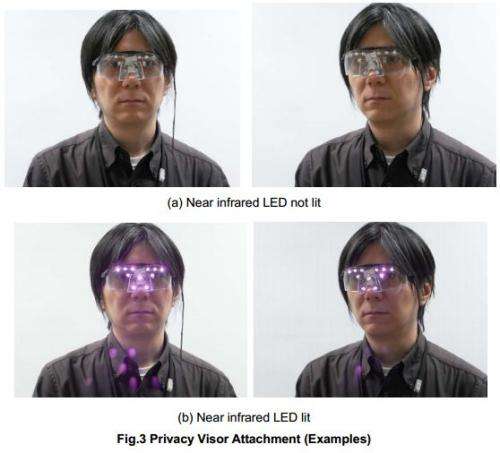Credit: National Institute of Informatics
(Phys.org)—People generally like the idea of facial recognition technology, if they are asked about it in the context of identifying dangerous killers on the loose and people out to spread mayhem. People generally hate the idea of facial recognition technology in the context of their own faces showing up without their permission on social networking sites or on databases designed to boost a company's sales. As law-enforcement and commercial companies explore facial recognition technologies, privacy groups are throwing up red flags.
They are alerting the public that facial surveillance may not only become very advanced but very ubiquitous. From Japan, scientists are offering an anti-surveillance visor, designed as a tool to thwart facial recognition technology. Isao Echizen, associate professor at Tokyo's National Institute of Informatics, jointly with Prof. Seiichi Gohshi of Kogakuin University, are working on infrared LED glasses for evading facial recognition.
According to the official release from the National Institute of Informatics, this is "technology for protecting photographed subjects from the invasion of privacy caused by photographs taken in secret and unintentional capture in camera images."
The release said their new development "can disable facial recognition of photographed subjects only when photos are taken. It achieves this by the photographed person wearing a privacy visor that incorporates a near-infrared light source that affects only the camera and not people's vision."
The two worked on the glasses to protect individuals who do not want their images uploaded online without permission or their image to be searchable via facial recognition software on online sites. The glasses, in prototype, make use of the concept of near-infrared light to block face recognition cameras. The glasses create glare using 11 infrared LED lights, which are not visible to the human eye but are to digital cameras. The near-infrared LEDs were implemented on the basis of arrangement of the "noise" light source.
Echizen began experimenting using light sources to create "noise" across key areas of the face used in the recognition process, to render the recognition software useless. He especially targeted the areas around the eyes and nose, which are the significant facial areas used for identification.
The glasses in their present state are goggle-shaped with small circular lights. They are connected to a wire and a battery that the user carries in the pocket.
Brian Ashcraft, a journalist based in Japan, noted that the goggles were shown on TV Tokyo last year. Echizen has received expressions of interest from companies toward commercializing the visors.
Echizen said further developments in this privacy visor will involve an improved version without a power supply consisting of transparent materials reflecting or absorbing specific wavelengths. He predicted that the device could be reasonably priced.
More information:
www.nii.ac.jp/en/news/2012/1212
www.nii.ac.jp/userimg/press_20121212e.pdf
www.nii.ac.jp/userimg/press_details_20121212.pdf
© 2013 Phys.org





















